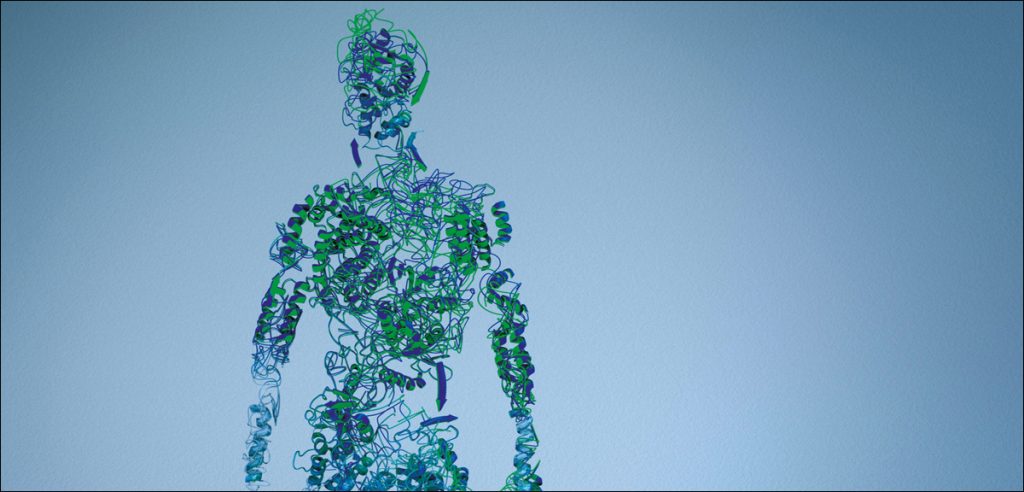There are a myriad amazing thing about the recent discovery of over 200 million protein structures by Google’s AI AlphaFold, says Satyen K. Bordoloi even as he evaluates its world-changing impact
Protein is the very essence of life. All life on Earth is because of the elusive nature of how proteins fold. If proteins did not fold into 3D structures, you wouldn’t have all these complex biological manifestations that constitute all life on this planet. Even if we look at our individual lives, everything – from your ability to walk or talk, dexterity or proprioception, is dependent on protein folds.
Thus, when Google’s AI arm DeepMind announced that in partnership with European Bioinformatics Institute, its Artificial Intelligence system AlphaFold has managed to simulate the predicted structures of nearly all catalogued proteins known to science i.e. a whopping 200 million plus structures, the whole world let out a collective gasp. According to Google, it has the “potential to dramatically increase our understanding of biology.” If you ask someone with an awareness of history, they’ll say three words – it changes everything.
In the words that AlphaFold engineers and researchers put out to announce this: “Proteins are the building blocks of life, they underpin every biological process in every living thing. And, because a protein’s shape is closely linked with its function, knowing a protein’s structure unlocks a greater understanding of what it does and how it works.”
Let us look only at the human body.
Protein is essentially a chain of amino acids. When you consume foods with protein, they are broken down by the body into constituent amino acids during digestion. Different types of these amino acids travel where it is needed, join and fold together in different ways to build and repair our cells and body tissues: muscle, bone, skin, hair etc., help blood clotting, immune responses, and how our hormones and enzymes are made and regulated. As every cell in our body contains protein, it becomes the building block of life.


It is thus not difficult to understand what and where the 200 million structures predicted by AlphaFold would help. The same team, a year ago in July 2021, had released the structure of over 3,50,000 protein structures that included proteome i.e. the 20,000 proteins in the human genome along with proteins found in 20 other biologically significant organisms. Back then the team planned to use AlphaFold AI to predict 100 million structures. It ended up doubling that count within a year.

This “veritable protein almanac of the world” which the team named AlphaFold DB, within just a year, had been accessed by over half a million researchers from 190 countries and “used to accelerate progress on important real-world problems ranging from plastic pollution to antibiotic resistance.”
From speeding up the discovery of new treatments for potentially fatal parasitic illnesses, to understanding honey bee immunity, to piecing together a model of the nuclear pore complex – one of the largest molecular machines in human cells, to understanding how differences in individuals and species occur i.e. how DNA changes, this last year has been a year of discovery thanks to the 3,50,000 protein structures released by the team.

Google has been the reason for AI being what it is today. A decade ago, it used its dominant position to push for research and development into AI, creating application that no one thought AI could do. Even winning in chess and Go, was serious fun and games for them. Yet, AlphaFold has been the most complex AI system they have built requiring multiple critical innovations. And the results are there for everyone to see.
“By demonstrating that AI could accurately predict the shape of a protein down to atomic accuracy, at scale and in minutes, AlphaFold not only provided a solution to a 50-year grand challenge, it also became the first big proof point of our founding thesis: that artificial intelligence can dramatically accelerate scientific discovery and in turn advance humanity.”
Earlier, one protein fold discovery would take a dedicated team months to predict. By reducing this discovery time to minutes, it has not only saved millions of collective days of research, but this human intellectual power is now free to instead focus on other life-saving discoveries. This will eventually result not only in treating as yet untreatable diseases but to ‘solving’ – at least partially – the greatest ‘disease’ and scrouge of humankind: death.


(Image: DeepMind)
What is most amazing about this is that Google has not patented this when it could have, and instead has made it open source for anyone and everyone to take advantage of. Monetarily speaking, though it cannot be guessed over a lifetime, it is at least dozens of trillions of dollars worth gift to mankind. Emotionally and humanistically speaking, this surpasses Jonas Salk who famously refused to patent his polio vaccine by asking: can you patent the sun?
This is just the start. New branches of biology will open up because of this. And a little-known one – Digital Biology – will receive a big booster shot to its fortunes. Medicine and pharma industries will change and most of all, how we live and how we are medically treated, what we are treated for and how fast, will all change because of this.
This is just the first and behind it are many more suns to be discovered or invented. One only hopes that others too – like Jonas Salk and Google, realise that if humanity has to reach its full potential, it can do so only if others too refuse to patent the sun.
In case you missed:
- Prizes for Research Using AI: Blasphemy or Nobel Academy’s Genius
- A Manhattan Project for AI? Here’s Why That’s Missing the Point
- The Most Revolutionary Treatment Ever Just Became Available to You
- How Old Are We: Shocking New Finding Upends History of Our Species
- The Rise of Personal AI Assistants: Jarvis to ‘Agent Smith’
- Rethinking AI Research: Shifting Focus Towards Human-Level Intelligence
- Google’s Willow Quantum Chip: Separating Reality from Hype
- Susan Wojcicki: The Screaming Legacy of The Quiet Architect of the Digital Age
- The Path to AGI is Through AMIs Connected by APIs
- Google Falters Under AI Onslaught: Future of Search in Peril?










4 Comments
Hi to all, how is all, I think every one is getting more from this site, and your views are
pleasant designed for new viewers.
What’s up, just wanted to mention, I liked this post. It was practical.
Keep on posting!
Thank you for sharing the information about google ai predicting protein fold changes everything, it is good article.
This is really interesting, You’re a very skilled blogger.
I have joined your feed and look forward to seeking
more of your magnificent post. Also, I’ve shared your web site in my social networks!